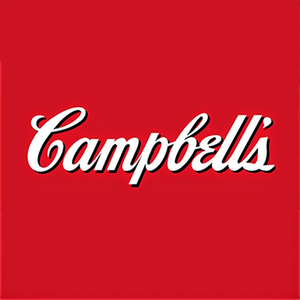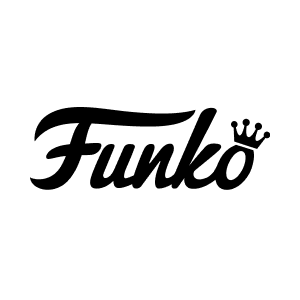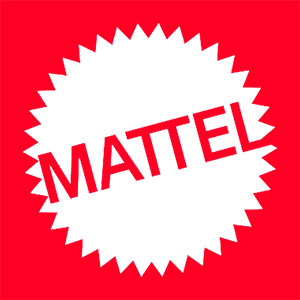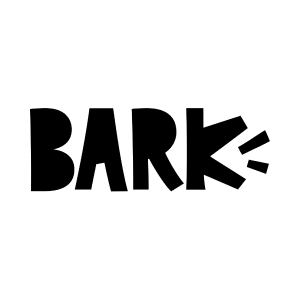
Bark (BARK)
Bark faces an uphill battle. Its poor revenue growth shows demand is soft and its cash burn makes us question its business model.― StockStory Analyst Team
1. News
2. Summary
Why We Think Bark Will Underperform
Making a name for itself with the BarkBox, Bark (NYSE:BARK) specializes in subscription-based, personalized pet products.
- Lackluster 9.8% annual revenue growth over the last five years indicates the company is losing ground to competitors
- Sales are projected to tank by 7.4% over the next 12 months as its demand continues evaporating
- Limited cash reserves may force the company to seek unfavorable financing terms that could dilute shareholders


Bark doesn’t check our boxes. There’s a wealth of better opportunities.
Why There Are Better Opportunities Than Bark
Why There Are Better Opportunities Than Bark
Bark’s stock price of $0.65 implies a valuation ratio of 29.6x forward EV-to-EBITDA. Not only is Bark’s multiple richer than most consumer discretionary peers, but it’s also expensive for its revenue characteristics.
We prefer to invest in similarly-priced but higher-quality companies with superior earnings growth.
3. Bark (BARK) Research Report: Q3 CY2025 Update
Pet products provider Bark (NYSE:BARK) reported Q3 CY2025 results exceeding the market’s revenue expectations, but sales fell by 15.2% year on year to $107 million. On the other hand, next quarter’s revenue guidance of $102.5 million was less impressive, coming in 4% below analysts’ estimates. Its non-GAAP loss of $0.03 per share was $0.02 below analysts’ consensus estimates.
Bark (BARK) Q3 CY2025 Highlights:
- Revenue: $107 million vs analyst estimates of $104.3 million (15.2% year-on-year decline, 2.6% beat)
- Adjusted EPS: -$0.03 vs analyst estimates of -$0.02 ($0.02 miss)
- Adjusted EBITDA: -$1.44 million vs analyst estimates of $267,670 (-1.3% margin, significant miss)
- Revenue Guidance for Q4 CY2025 is $102.5 million at the midpoint, below analyst estimates of $106.7 million
- EBITDA guidance for Q4 CY2025 is -$3 million at the midpoint, below analyst estimates of -$1.43 million
- Operating Margin: -10%, down from -4.5% in the same quarter last year
- Free Cash Flow was -$19.93 million, down from $966,000 in the same quarter last year
- Market Capitalization: $134.2 million
Company Overview
Making a name for itself with the BarkBox, Bark (NYSE:BARK) specializes in subscription-based, personalized pet products.
The company's journey started with a vision: to fill a gap in the market for high-quality, engaging, and personalized pet care items. This concept quickly gained traction during COVID-19, leading to its June 2021 SPAC debut.
Bark's primary offerings include subscription-based bundles such as BarkBox and Bark Super Chewer, which contain a customized selection of toys, treats, and chews. These bundles can be purchased online and scheduled for home delivery. Additionally, Bark sells pet food and dental products, and its goods can also be found at retailers like Target.
Bark’s customers are affectionate pet owners who prioritize their pets' happiness and well-being. The company's revenue is primarily derived from subscription services, supplemented by direct sales of individual products. Maintaining its subscription revenue base is key to its success.
4. Toys and Electronics
The toys and electronics industry presents both opportunities and challenges for investors. Established companies often enjoy strong brand recognition and customer loyalty while smaller players can carve out a niche if they develop a viral, hit new product. The downside, however, is that success can be short-lived because the industry is very competitive: the barriers to entry for developing a new toy are low, which can lead to pricing pressures and reduced profit margins, and the rapid pace of technological advancements necessitates continuous product updates, increasing research and development costs, and shortening product life cycles for electronics companies. Furthermore, these players must navigate various regulatory requirements, especially regarding product safety, which can pose operational challenges and potential legal risks.
Competitors operating in the pet care and products industry include Chewy (NYSE:CHWY), Petco (NASDAQ:WOOF), and Amazon (NASDAQ:AMZN).
5. Revenue Growth
Reviewing a company’s long-term sales performance reveals insights into its quality. Any business can put up a good quarter or two, but the best consistently grow over the long haul. Regrettably, Bark’s sales grew at a tepid 9.8% compounded annual growth rate over the last five years. This was below our standard for the consumer discretionary sector and is a poor baseline for our analysis.
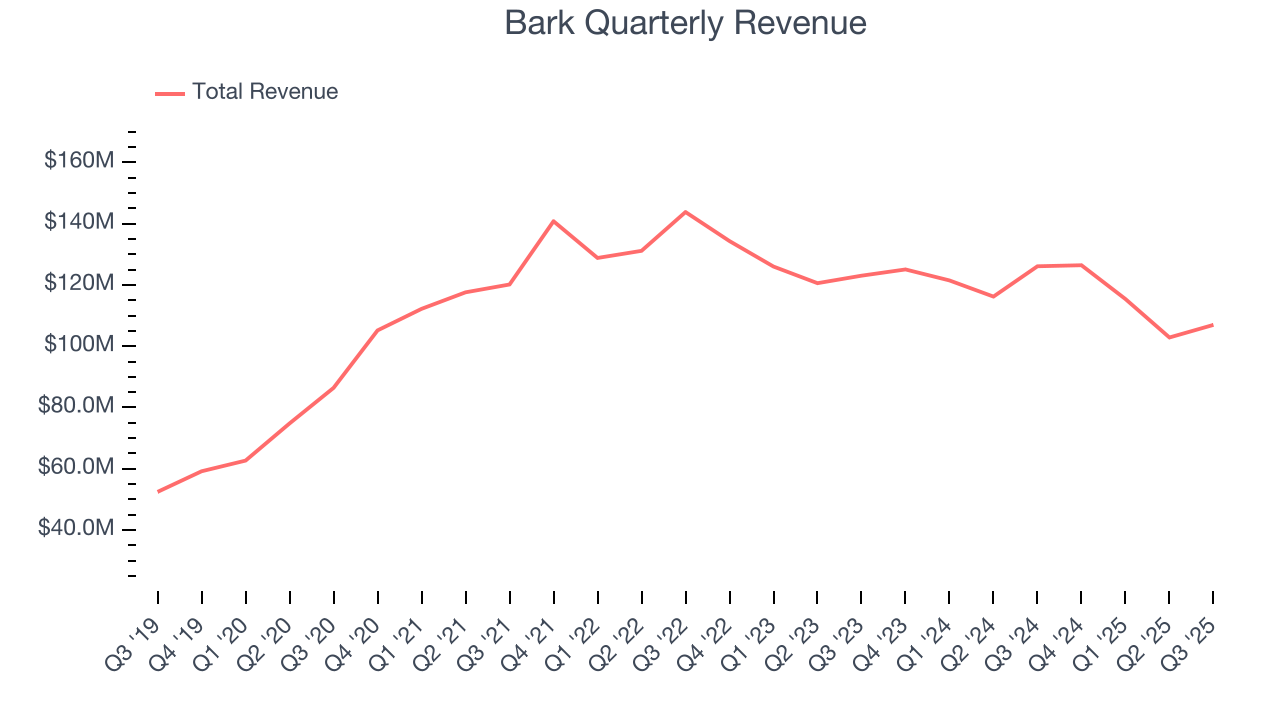
We at StockStory place the most emphasis on long-term growth, but within consumer discretionary, a stretched historical view may miss a company riding a successful new product or trend. Bark’s performance shows it grew in the past but relinquished its gains over the last two years, as its revenue fell by 5.3% annually. 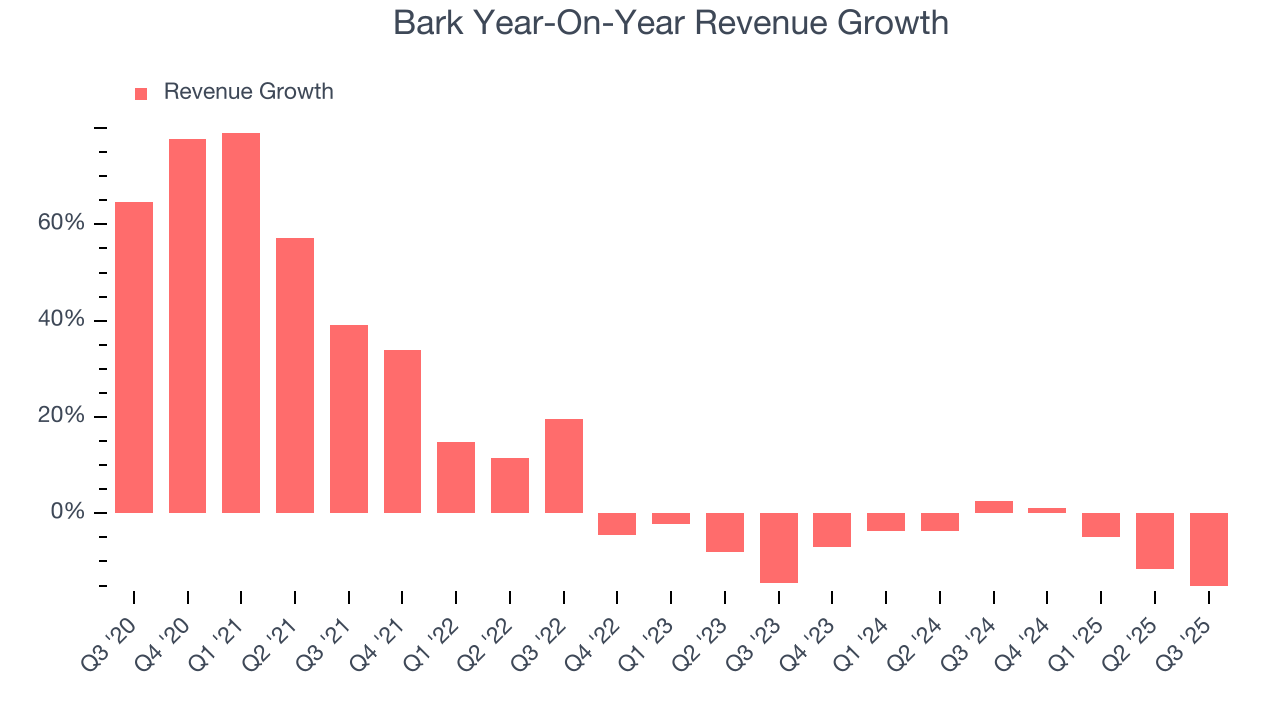
This quarter, Bark’s revenue fell by 15.2% year on year to $107 million but beat Wall Street’s estimates by 2.6%. Company management is currently guiding for a 18.9% year-on-year decline in sales next quarter.
Looking further ahead, sell-side analysts expect revenue to decline by 5.3% over the next 12 months, similar to its two-year rate. This projection doesn't excite us and suggests its newer products and services will not catalyze better top-line performance yet.
6. Operating Margin
Operating margin is an important measure of profitability as it shows the portion of revenue left after accounting for all core expenses – everything from the cost of goods sold to advertising and wages. It’s also useful for comparing profitability across companies with different levels of debt and tax rates because it excludes interest and taxes.
Bark’s operating margin might fluctuated slightly over the last 12 months but has remained more or less the same, averaging negative 7.9% over the last two years. Unprofitable consumer discretionary companies that fail to improve their losses or grow sales rapidly deserve extra scrutiny. For the time being, it’s unclear if Bark’s business model is sustainable.
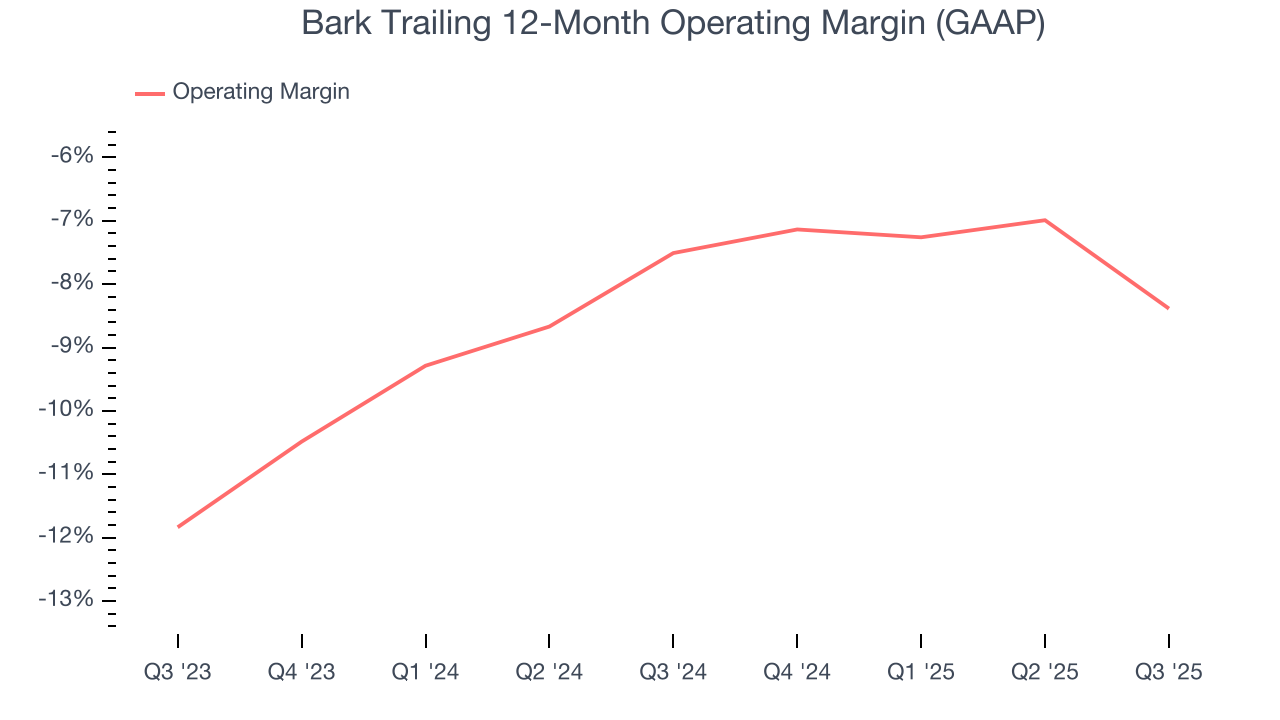
This quarter, Bark generated a negative 10% operating margin. The company's consistent lack of profits raise a flag.
7. Earnings Per Share
Revenue trends explain a company’s historical growth, but the change in earnings per share (EPS) points to the profitability of that growth – for example, a company could inflate its sales through excessive spending on advertising and promotions.
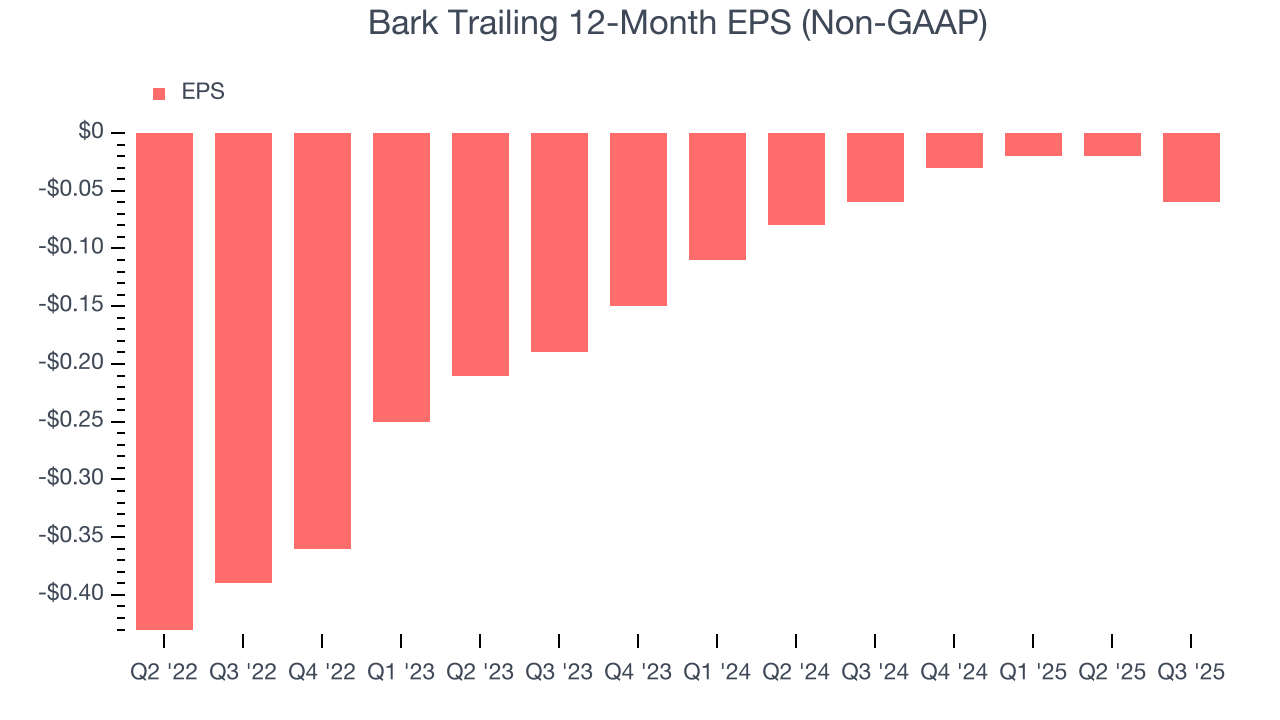
In Q3, Bark reported adjusted EPS of negative $0.03, down from $0.01 in the same quarter last year. This print missed analysts’ estimates. Over the next 12 months, Wall Street expects Bark’s full-year EPS of negative $0.06 to stay about the same.
8. Cash Is King
Free cash flow isn't a prominently featured metric in company financials and earnings releases, but we think it's telling because it accounts for all operating and capital expenses, making it tough to manipulate. Cash is king.
Over the last two years, Bark’s demanding reinvestments to stay relevant have drained its resources, putting it in a pinch and limiting its ability to return capital to investors. Its free cash flow margin averaged negative 3.1%, meaning it lit $3.11 of cash on fire for every $100 in revenue.
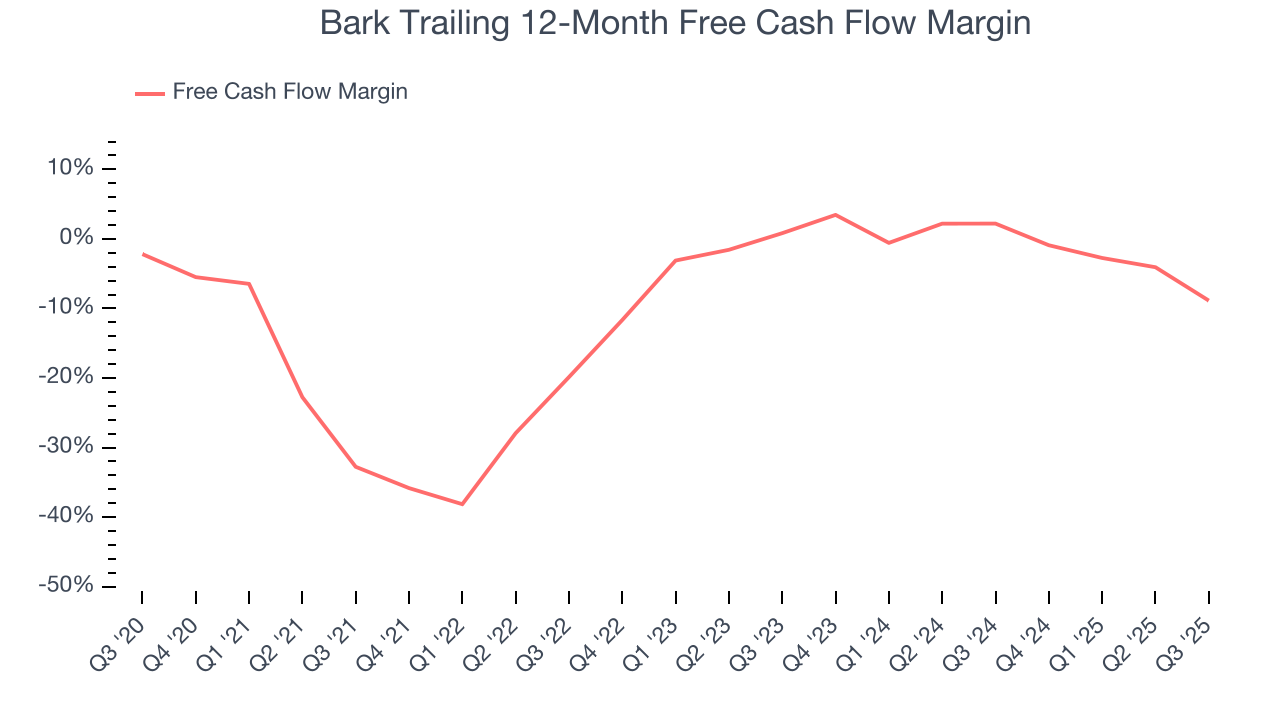
Bark burned through $19.93 million of cash in Q3, equivalent to a negative 18.6% margin. The company’s cash burn increased meaningfully year on year while its cash conversion fell 19.4 percentage points. This relationship shows Bark’s management team spent more cash this quarter but was less efficient at generating sales with that cash.
9. Balance Sheet Risk
As long-term investors, the risk we care about most is the permanent loss of capital, which can happen when a company goes bankrupt or raises money from a disadvantaged position. This is separate from short-term stock price volatility, something we are much less bothered by.
Bark burned through $40.03 million of cash over the last year, and its $82.57 million of debt exceeds the $63.43 million of cash on its balance sheet. This is a deal breaker for us because indebted loss-making companies spell trouble.
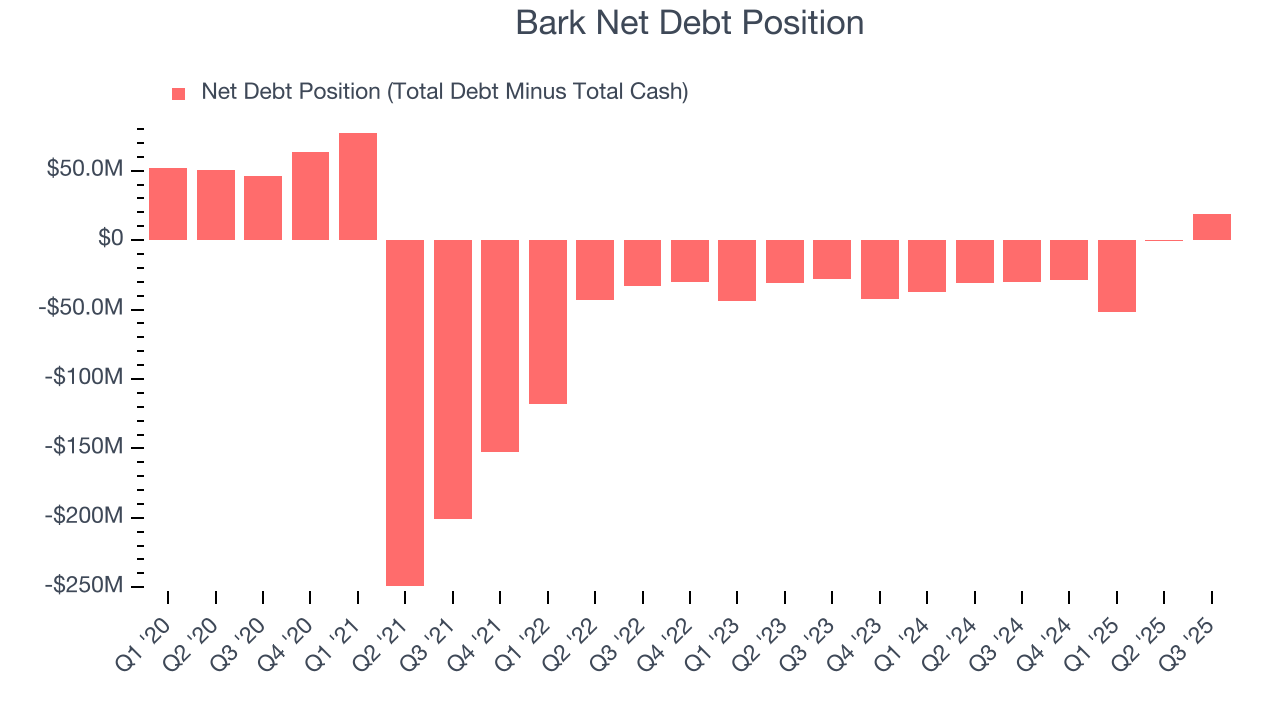
Unless the Bark’s fundamentals change quickly, it might find itself in a position where it must raise capital from investors to continue operating. Whether that would be favorable is unclear because dilution is a headwind for shareholder returns.
We remain cautious of Bark until it generates consistent free cash flow or any of its announced financing plans materialize on its balance sheet.
10. Key Takeaways from Bark’s Q3 Results
It was encouraging to see Bark beat analysts’ revenue expectations this quarter. On the other hand, its EPS was just in line with Wall Street’s estimates and revenue guidance fell below estimates. Overall, this was a weaker quarter. The stock traded up 1.2% to $0.81 immediately after reporting.
11. Is Now The Time To Buy Bark?
Updated: December 24, 2025 at 10:04 PM EST
The latest quarterly earnings matters, sure, but we actually think longer-term fundamentals and valuation matter more. Investors should consider all these pieces before deciding whether or not to invest in Bark.
We cheer for all companies serving everyday consumers, but in the case of Bark, we’ll be cheering from the sidelines. To begin with, its revenue growth was weak over the last five years, and analysts expect its demand to deteriorate over the next 12 months. And while its astounding EPS growth over the last three years shows its profits are trickling down to shareholders, the downside is its projected EPS for the next year is lacking. On top of that, its cash burn raises the question of whether it can sustainably maintain growth.
Bark’s EV-to-EBITDA ratio based on the next 12 months is 29.6x. At this valuation, there’s a lot of good news priced in - we think there are better stocks to buy right now.
Wall Street analysts have a consensus one-year price target of $2.33 on the company (compared to the current share price of $0.65).
Although the price target is bullish, readers should exercise caution because analysts tend to be overly optimistic. The firms they work for, often big banks, have relationships with companies that extend into fundraising, M&A advisory, and other rewarding business lines. As a result, they typically hesitate to say bad things for fear they will lose out. We at StockStory do not suffer from such conflicts of interest, so we’ll always tell it like it is.
